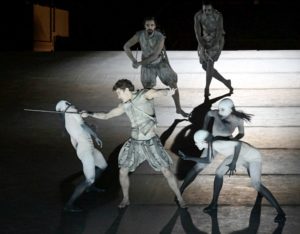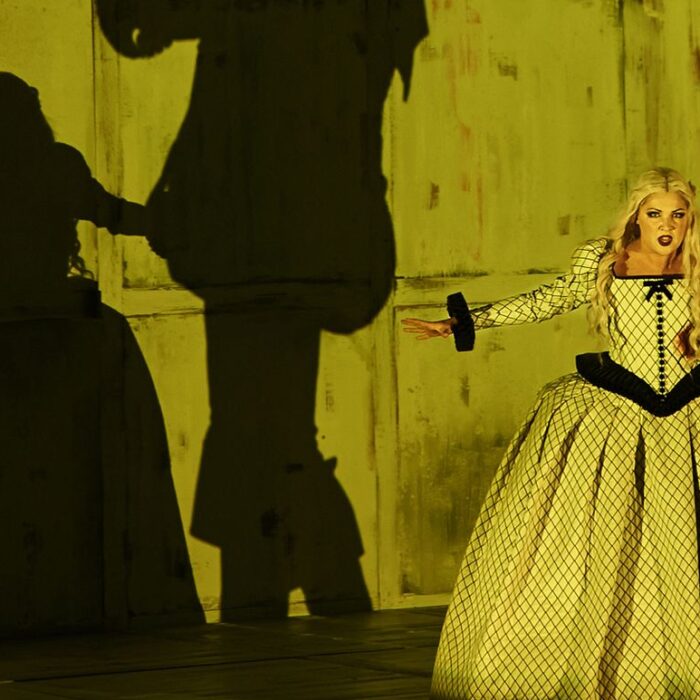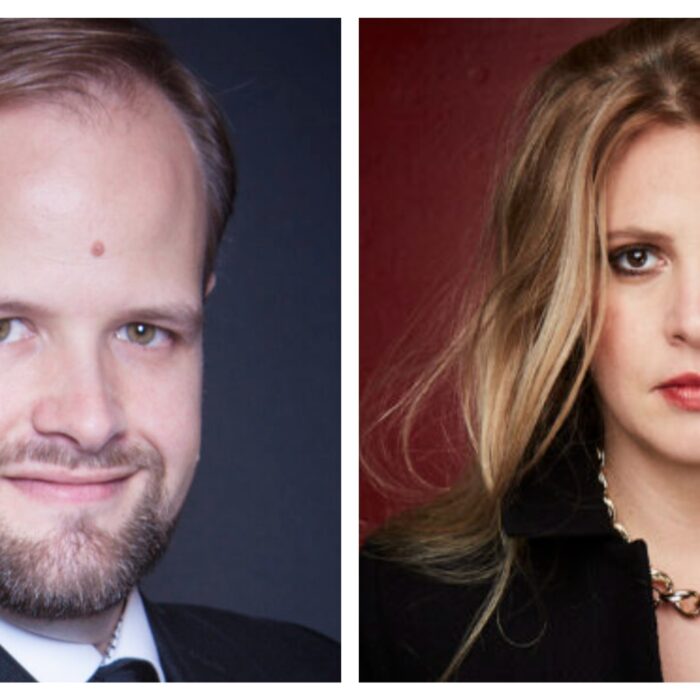
Oper Frankfurt 2018-19 Review: Rinaldo
By Jonathan SutherlandMost musicologists concur that Handel did a major cut and paste job on “Rinaldo,” as more than two thirds of the score was cribbed from earlier compositions.
There are also three versions of this tremendously successful opera from 1711, 1717 and 1731. Depending on singers’ availability and vocal condition, innumerable nips and tucks occurred at almost all 53 performances during Handel’s lifetime. Such a flexible if not fainéant approach by the composer seems to justify all sorts of solecisms by contemporary directors ranging from Robert Carsen’s schoolroom shenanigans at Glyndebourne to Giorgio Sangat’s pop-star production of Leonardo Leo’s rewrite at the Martina Franca Festival last summer where Rinaldo was reincarnated as Freddie Mercury.
With one or two reservations, American regisseur Ted Huffman took a more conventional approach for Oper Frankfurt in the former Bockenheimer Depot tram garage.
A More Traditional Approach
First seen last year, his production is as abundant in memorable images as Armida’s arsenal of magic tricks. The dramaturgy is more controversial. The existential conflict between self-righteous Crusaders and pernicious Saracens as described by Torquato Tasso in “La Gerusalemme liberate” is essentially glossed over. Of primary interest is the personal dynamic between the principal characters in Aaron Hill’s libretto. Contemporary political correctness aside, Huffman’s ending is certainly original if not exactly musically congruous. Handel made drastic changes to the plot between the 1711 and 1731 versions in that Armida and Argante were originally converted to Christianity and all ends happily ever after. With a little more Weltpolitikrealismus in the last revision, Handel has the dastardly duo disappear in the nick of time in a fiery dragon-drawn chariot, presumably to fight another day. Huffman rejects both hypotheses and has Armida kill her philandering paramour, ironically straight after “dolce premio ti vuol dar!” The perfidious pythoness is then herself dispatched to purgatory by Rinaldo’s trusty spada during the battaglia. Having rightly rid the world of a baroque Bellatrix Lestrange, the hero then hurls away not only Goffredo’s flashy medallon for valor but also his own Excalibur, presumably to join an 11th century Pacifist Movement and live in wedded bliss with Almirena whose tears are now drier than the Nubian dessert.
Annemarie Woods’ minimalist stage design uses an exceptionally steep rake which worked admirably. As there is no proscenium in the converted tram shed, the mis-en-scène was stylishly spartan. The human chain of soldiers trying to impede Rinaldo’s seduction and demise was a very clever coup de théâter but the hero’s subsequent ensnarement in long ropes held by Armida’s loathsome little helpers was even more effective. Raphaela Roses’ chic silvery patina costumes for the Crusaders could have been Lacroix in medieval mode. Basic black for Argante and Armida made the bad guys as different to the Christians as kabsa is to kippers. Cobbler’s costs were non-existent as all characters were barefooted, which could have been an erudite reference to the prophecy of Adhemar but was more likely a practical measure to stop the performers sliding down the precipitous stage into the orchestra. Joachim Klein’s lighting was truly inspired creating subtle mood changes and striking silhouettes.
Complete Spectacle
Eight dancers play an important role in this production and New York choreographer Adam Weinert had no shortage of savvy ideas. Like mute versions of the Queen of the Night’s Ladies, Armida is aided and abetted by three androgynous bald-headed leaping Ninjas-cum-Furies who perform all kinds of acrobatic tricks, help with the scene changes and react to events with fascinating Gollum-esque twists of the head and body. Despite looking more like fabulous fitness hunks from a mid-town Equinox gym than poorly fed 11th century foot soldiers, the male dancers engaged in plenty of gymnastics and swashbuckling sword play.
The premiere of “Rinaldo” featured spectacular stage effects such as fire-breathing dragons and chariots zooming through the sky. Most memorable however was a flock of live birds let loose in the auditorium during Almirena’s “Augelletti” scene. How the feathered friends were persuaded to exitus ad principes remains a mystery. Huffman wisely culled the canaries so no inadvertent avian droppings marred the proceedings. The garden scene was still imaginatively staged with the three Hobbity harpies turned into peripatetic aborealists swinging leafy branches over the canoodling couple as a mysterious moose-man cervitaur meanders in the background.
Mixing Things Up
Given the quantum differences between renowned Handel experts ranging from Hogwood and Jakubs to Bicket and Butt, there will never be an easy consensus as to cuts and voice casting. That said, musical director Simone Di Felice made some curious choices. Goffredo was sung by a mezzo and Eustazio by a bass with a significant amount of music for both roles omitted. The Christian magician had already port-keyed to heaven. Most disturbing however were the modifications to the performance order. Armida’s “Vo’ far guerra” was moved to follow Goffredo’s “Sorge nel petto” and Almirena’s “Combatti da forte” jumped forward two Acts making the pertinence of the recitatives dubitable. With a total running time of c. 145 minutes Di Felice was significantly shorter than Christopher Hogwood’s Decca CD at 168 minutes or René Jakubs 2003 recording for Harmonia Mundi which ambles along for a full 195 minutes. Conversely, Di Felice was almost 25 minutes longer than Ottavio Dantone in Pier Luigi Pizzi’s acclaimed Ravenna production which feels like a Handel tweet.
The Italian maestro led a relatively large Frankfurter Opern und Museumsorchester with precision if not unbridled passion. That said, there was elegance in the opening sinfonia, sensitive string playing in the lento and adagio arias and some virtuoso woodwind work from oboe and flageolet. Requisite raucousness enlivened the trombe da tirasi during the martial sections but there was a lack of bite from baroque bassoon. Similarly Sebastian Wienand’s cembalo solos opted for exactitude rather than exuberance and the extended improvisations in “Vo’ far Guerra” tended to follow precise notation rather than freely extemporize as was Handel’s preference.
Eustazio is hardly the most charismatic Crusader in the Holy Land and young Polish bass Daniel Mirosław didn’t do much to change that. There was blandness in characterization and vocally the performance was more tepid than tenacious. “Sulla ruota di fortuna,” “Scorta rea di cieco,” and “Di Sion nell’alta sede” all went to the shredders. “Col valor, colla virtue” was replaced with “Solo dal brando” which is usually sung by Goffredo after the battaglia. Mirosław’s focus was mostly muddy and diction indistinct. “Siam prossimi al porto” was restored, but sounded far too ominous with a bass sonority. Mirosław has an agreeable lyric timbre, but whether the voice is ideally suited to baroque music is debatable.
Questionable Casting
As the Crusader King Goffredo, Julia Dawson looked ridiculous hobbling around on two walking poles. This was hardly a virile warrior resolved to recapture Jerusalem. An absurd wig made the mezzo look more like a hirsute hippy Titurel. Handel’s first Goffredo was contralto Francesca Vanini-Boschi, but Dawson’s upper range is more solid than anything below the stave. “Sovra balze scoscesi e pungenti” lacked focus, diction was desultory and dotted rhythms ill-defined. The gear change between chest and head voice in the roulades was anything but seamless. Further fuzzy intonation characterized “Nò, nò, che quest’alma” although the fermata on “Gloria” and opening “Nò, nò’s” in the da capo had punch. “Sorge nel petto” was much more satisfactory.
Almirena is at best angelic and at worst anemic and Huffman didn’t do much to expand the stereotype. American soprano Karen Vuong has a clear, forward-placed voice with an agreeable mezzo-ish colour. “Augelletti, che cantata” was sung sweetly enough but the chirpy flageolet and flauti dolci made a more memorable impression. In “Lascia ch’io pianga,” Almirena gets the opera’s most famous aria, even if in its third reincarnation. Vuong delivered the usual show-stopper with a warm timbre and pleasing evenness of tone but was slightly mannered. There was charming word coloring on “martiri” but the da capo ornamentation was banal. When it finally appeared, “Combatti da forte” was adequate without being exceptional and “Bel piacere e godere” even less interesting.
Basso Baddie
As the alpha-male Argante, Canadian bass Gordon Bintner was in every respect an ideal basso baddie. Physically imposing with a Wotan-esque Yggdrasil staff in hand, there was also powerful projection in the snarling “Sibillar gli angui d’Aletto” aria. Bintner’s top F-sharps were rock solid, roulades squeaky clean and the macarto rallentando on “pena mi diè” brazen and brassy. Diction in the recitatives was consistently exemplary. There was impressive contrasting cantabile in the lilting “Vieni, o cara” aria, bolstered by some chocolaty low A-naturals and refulgent top F’s ending with a mellifluous embellishment on “seren”. The “Al trionfo del nostro furore” duet with Armida was a tussle of equals in both viciousness and vocalism.
Dominant Diva
Even in the 11th century, not a lot of good things came out of Damascus. Dressed in a ravishing ruched black ballgown, Armida was a composite Königin der Nacht/Cruella de Vil in dominatrix mode. American soprano Elizabeth Reiter clearly relished the role and her vocal fireworks were incendiary whilst retaining impeccable intonation. From the first manic G-natural fermata on “Furie terribilli” it was clear that Rinaldo had one stroppy sorceress to deal with. The huge leaps, plumy low D naturals, interpolated high B flats and rapid roulades were dazzling.
The sprightly “Molto voglio, molto spero” displayed the precision of Reiter’s crisp intonation with some wonderful Horne-esque chest notes on “dubitar”. “Ah! crudel” was almost convincing in its ingenuousness until Armida’s true character exploded back with some pristine pyrotechnics in the presto section. “Crudeltà” was particularly nasty. The transplanted “Vo’ far guerra” aria showed no diminution in the scintillating runs and roulades.
Perfect Rinaldo
It would be hard to imagine a better Rinaldo than Jakub Józef Orliński.
Not only does the handsome young Polish countertenor have every technical accoutrement in his prodigious vocal armament, he looks entirely credible. The singer combines the innate musicality of Iestyn Davies with the flamboyant fioratura of Franco Fagioli to create a uniquely Orliński stage and vocal persona. His remarkable physicality testifies to yet another talent as an accomplished break-dancer.
The gifted Pole is also a superb actor and rarely has “Cara sposa’ been sung with such gut-wrenching pathos. Handel considered it the finest aria he ever wrote and Orliński did the scena full justice. Lying on the ground in abject misery, his opening B-natural fermata on “cara” seemed to come from the depths of the young man’s anima and last forever. Phrasing was peerless and evenness of melodic line exquisite. The E-E octave drop on “ritorna” was so perfectly pitched it was almost eerie. The resonant low D-sharps were only surpassed by plangent low B-naturals on “sei” and “rei” and the fermata on “pianti.” There was immaculate trilling on “miei” before the allegro section which showed a flash of warrior metal on “Del vostro Erebo sull’ara.” Orliński’s embellishments, controlled crescendi and anguished phrasing on “Dove sei” in the da capo was Handelian singing at its absolute finest.
The following “Cor ingrato, ti rammembri” was no less impressive. Completing the virtuoso trifecta ending the first Act, “Venti, turbini, prestate” was electrifying with laser-accurate semiquaver roulades and a killer cadenza at the da capo which dropped to a low G-natural which meant that at orchestral pitch of Hz 415, it was actually a G-flat. “È un incendio fra due venti” and “Il Tricerbero humiliate” were regrettably cut but a riveting top G-flat on “Lasica mi” in the “Fermati!/No, crudel!” duet with Armida almost made up for it. There was serious scorching and blazing in “Abbrugio, avampo e fremo” with another shower of rapid roulades. “Or la tromba” was a rousing raucous finale and Orliński’s ornamentation was again sensational. His bravura forte singing never strayed from absolute pitch. No wonder the Saracens were defeated.
Orliński will sing Eustazio in Glyndebourne this summer with Elizabeth DeShong in the title role. If ever there was a case for urgent re-casting, this is one. With a shrewd eye for star performers, Handel would undoubtedly agree.


